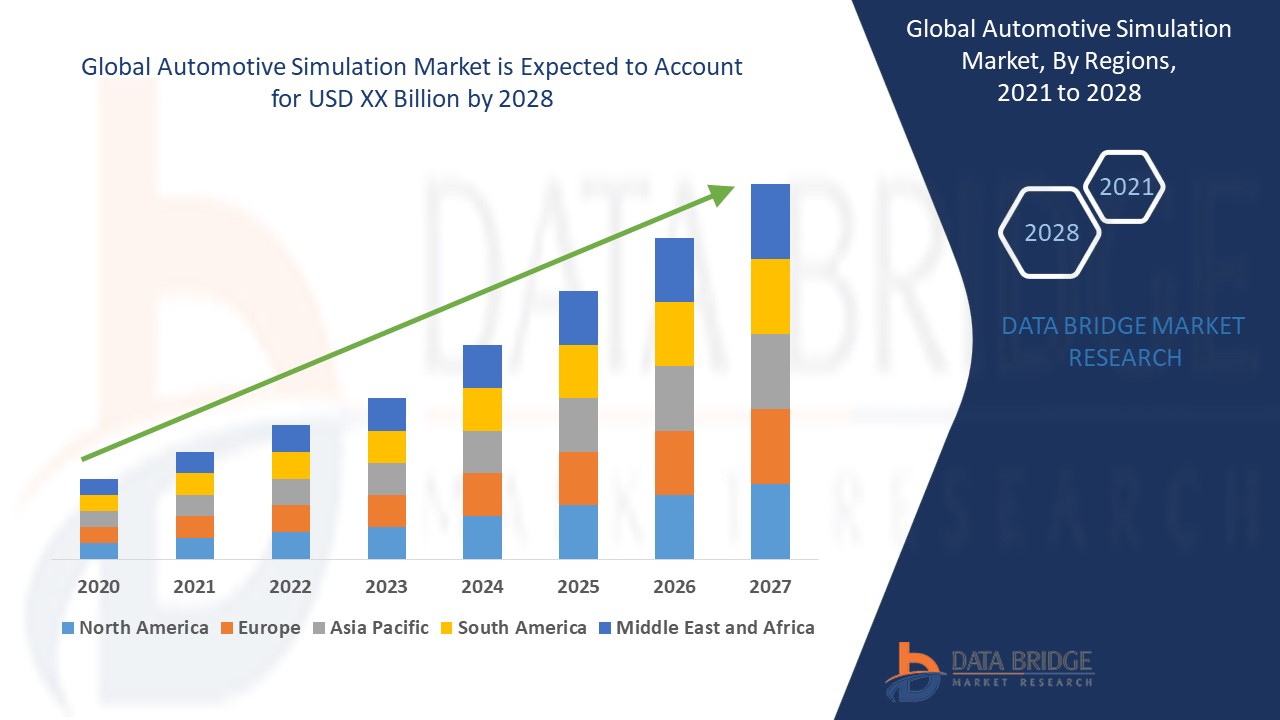Global Automotive Simulation Market
市场规模(十亿美元)
CAGR :
% 
 USD
2.41 Billion
USD
5.76 Billion
2023
2031
USD
2.41 Billion
USD
5.76 Billion
2023
2031
| 2024 –2031 | |
| USD 2.41 Billion | |
| USD 5.76 Billion | |
|
|
|
全球汽车模拟市场细分,按部署(本地和云)、组件(软件和服务)、终端市场(OEM、汽车零部件制造商和监管机构)、应用(原型设计和测试)– 行业趋势和预测到 2031 年。
汽车仿真市场分析
汽车系统日益复杂,对成本效益高、设计流程高效的要求日益增加,推动了汽车仿真市场显著增长。随着汽车制造商专注于缩短开发时间并提高车辆安全性和性能,对汽车仿真工具的需求也不断上升。人工智能、机器学习和自动驾驶系统等先进技术的融合进一步推动了对能够准确复制真实情况的仿真解决方案的需求。此外,严格的车辆安全和排放监管要求正推动制造商采用仿真技术以确保合规。电动汽车 (EV)的蓬勃发展也使市场受益,其中仿真在优化电池性能和能源管理方面发挥着至关重要的作用。
汽车模拟市场规模
2023 年全球汽车模拟市场规模价值 24.1 亿美元,预计到 2031 年将达到 57.6 亿美元,2024 年至 2031 年预测期内的复合年增长率为 11.5%。除了市场价值、增长率、细分市场、地理覆盖范围、市场参与者和市场情景等市场洞察外,Data Bridge 市场研究团队策划的市场报告还包括深入的专家分析、进出口分析、定价分析、生产消费分析和 pestle 分析。
汽车仿真市场趋势
“电动汽车(EV)的增长”
电动汽车 (EV) 的快速发展极大地推动了对先进仿真工具的需求,使其成为汽车行业的一个突出趋势。随着汽车制造商越来越专注于开发电动汽车以满足环境法规和消费者对可持续交通的需求,这些汽车的复杂性需要复杂的仿真技术。仿真工具对于优化电动汽车性能的关键方面至关重要,包括电池管理、能源效率和热调节。例如,在各种驾驶条件下准确模拟电池行为对于提高续航里程和使用寿命至关重要,而能源效率模拟有助于改进动力系统组件以最大限度地提高车辆性能。
此外,在构建物理原型之前,热管理系统(对于保持电动汽车的最佳工作温度至关重要)会通过仿真进行彻底测试和优化。这种对仿真的依赖不仅可以降低开发成本和上市时间,还可以确保最终产品符合严格的性能和安全标准。随着电动汽车市场的不断扩大,仿真在促进电动汽车开发和部署方面的作用将不断增强,从而推动仿真技术的进一步发展。
报告范围和市场细分
|
属性 |
汽车仿真关键市场洞察 |
|
分割 |
按部署:本地和云 按组件:软件和服务 按终端市场划分: OEM、汽车零部件制造商和监管机构 按应用:原型设计和测试 |
|
覆盖国家 |
美国、加拿大、墨西哥、德国、法国、英国、荷兰、瑞士、比利时、俄罗斯、意大利、西班牙、土耳其、欧洲其他地区、中国、日本、印度、韩国、新加坡、马来西亚、澳大利亚、泰国、印度尼西亚、菲律宾、亚太其他地区、沙特阿拉伯、阿联酋、南非、埃及、以色列、中东和非洲其他地区、巴西、阿根廷、南美洲其他地区 |
|
主要市场参与者 |
Altair Engineering Inc.(美国)、ANSYS Inc.(美国)、PTC(美国)、Siemens AG(德国)、Autodesk Inc.(美国)、Dassault Systèmes(法国)、Synopsys Inc.(美国)、The MathWorks Inc.(美国)、ESI Group(法国)、IPG Automotive GmbH(德国)、AVL(奥地利)、COMSOL Inc.(美国)、dSPACE GmbH(德国)、OPAL-RT TECHNOLOGIES Inc.(加拿大)、SimScale(德国)和 The AnyLogic Company(美国) |
|
市场机会 |
|
|
增值数据信息集 |
除了市场价值、增长率、细分市场、地理覆盖范围、市场参与者和市场情景等市场洞察之外,Data Bridge 市场研究团队策划的市场报告还包括深入的专家分析、进出口分析、定价分析、生产消费分析和 pestle 分析。 |
汽车模拟市场定义
汽车仿真是指使用基于计算机的建模和仿真技术在虚拟环境中复制和分析车辆设计、性能和操作的各个方面。该技术使汽车制造商、工程师和研究人员无需物理原型即可测试和优化车辆系统、部件和整体行为。
汽车仿真市场动态
驱动程序
- 自动驾驶汽车日益受到关注
自动驾驶汽车必须在各种环境中行驶,应对不可预测的情况,并在没有人为干预的情况下确保乘客安全。仿真工具提供了一个受控环境,工程师可以在其中复制和分析自动驾驶汽车在道路上可能遇到的数千种场景。这包括测试多个传感器之间的相互作用、改进决策算法以及优化车辆对各种道路状况和障碍物的响应。模拟这些条件的能力对于推进自动驾驶汽车技术、减少对昂贵且耗时的物理测试的依赖以及加速实现安全、可靠和商业上可行的自动驾驶汽车至关重要。自动驾驶汽车的发展正在推动对汽车仿真的极大关注,因为这些汽车需要对复杂的算法、传感器系统和车辆动力学进行广泛的测试和验证。
- 人工智能和机器学习的进步
人工智能 (AI)和机器学习 (ML) 与汽车仿真工具的集成正在改变复杂车辆行为的建模和分析方式。AI 和 ML 算法通过从大量数据中学习并不断提高其复制真实场景的能力来提高模拟的预测准确性。这些技术可以更精确地建模车辆动力学、驾驶员行为和环境交互,这对于开发先进的汽车系统(包括自动驾驶、ADAS 和电动汽车)至关重要。在模拟中使用 AI 和 ML 还可以实现某些测试过程的自动化,从而减少手动分析所需的时间和精力。随着这些技术的不断发展,它们有望进一步增强汽车模拟的能力,从而推动市场增长。
机会
- 联网汽车的增长
在物联网 (IoT) 和车联网 (V2X) 技术的应用推动下,联网汽车迅速增长,对先进的仿真工具的需求也随之增加。联网汽车依靠复杂的通信网络与其他汽车、基础设施和云服务交换数据,从而实现实时交通更新、远程诊断和增强安全系统等功能。为了确保这些系统的可靠性和安全性,仿真工具用于对连接组件(包括传感器、通信协议和软件算法)之间的交互进行建模和测试。这些仿真有助于识别潜在问题、优化系统性能并确保联网汽车能够在各种环境中无缝运行,从而为市场增长创造机会。
- 基于云的仿真的扩展
云计算的日益普及正在通过提供可扩展、灵活且协作的仿真环境,彻底改变汽车仿真市场。基于云的仿真允许公司按需访问强大的计算资源,使他们无需昂贵的本地硬件即可运行复杂的仿真。这对于可能缺乏资源投资高端仿真基础设施的小型公司尤其有利。此外,基于云的平台促进了不同地点的团队之间的协作,从而实现了实时数据共享和联合分析。随着越来越多的汽车公司认识到基于云的仿真的好处,其采用预计将增加,从而为市场增长创造机会。
限制/挑战
- 初始成本高
汽车仿真市场的主要制约因素之一是购买先进仿真软件和硬件的初始成本高昂。这些工具通常需要大量的前期投资,这对于预算有限的小公司或初创公司来说可能是难以承受的。成本不仅包括购买软件和必要的硬件,还包括软件许可、维护和更新等持续费用。此外,实施仿真工具可能需要对员工进行专门培训,这增加了总体成本负担。虽然大型汽车制造商可能拥有足够的财力来承担这些成本,但规模较小的公司可能难以证明投资的合理性,这可能会限制他们在市场上的竞争力。
- 仿真工具的复杂性
汽车仿真工具的复杂性给其广泛应用带来了重大障碍,特别是对于不具备该领域专业知识的公司而言。这些工具旨在模拟复杂的车辆系统和行为,需要深入了解底层技术以及汽车设计和测试的具体要求。因此,工程师和技术人员需要接受大量培训才能有效使用仿真工具,这可能既耗时又费钱。此外,这些工具的复杂性意味着它们可能不易集成到现有的工作流程中,需要对流程和系统进行额外的调整。这种复杂性可能会阻碍公司采用仿真技术,从而对市场增长构成挑战。
本市场报告详细介绍了最新发展、贸易法规、进出口分析、生产分析、价值链优化、市场份额、国内和本地市场参与者的影响,分析了新兴收入领域的机会、市场法规的变化、战略市场增长分析、市场规模、类别市场增长、应用领域和主导地位、产品批准、产品发布、地域扩展、市场技术创新。如需获取更多市场信息,请联系 Data Bridge Market Research 获取分析师简报,我们的团队将帮助您做出明智的市场决策,实现市场增长。
全球汽车模拟市场范围
市场根据部署、组件、终端市场和应用进行细分。这些细分市场之间的增长情况将帮助您分析行业中增长缓慢的细分市场,并为用户提供有价值的市场概览和市场洞察,帮助他们做出战略决策,确定核心市场应用。
部署
- 本地
- 云
成分
- 软件
- 服务
终端市场
- 原始设备制造商
- 汽车零部件制造商
- 监管机构
应用
- 原型设计
- 测试
全球汽车模拟市场区域分析
对市场进行了分析,并按上述国家、部署、组件、终端市场和应用提供了市场规模洞察和趋势。
市场覆盖的国家包括美国、加拿大、墨西哥、德国、法国、英国、荷兰、瑞士、比利时、俄罗斯、意大利、西班牙、土耳其、欧洲其他地区、中国、日本、印度、韩国、新加坡、马来西亚、澳大利亚、泰国、印度尼西亚、菲律宾、亚太其他地区、沙特阿拉伯、阿联酋、南非、埃及、以色列、中东和非洲其他地区、巴西、阿根廷以及南美洲其他地区。
亚太地区预计将占据市场主导地位,因为该地区汽车产量高、基础设施发展迅速,而且 OEM 提供的无钥匙进入、自动泊车辅助和 HMI 系统等先进功能广泛可用。针对 OEM 的环保法规、持续的工业化以及制造商推出的创新汽车设计进一步促进了该地区市场的增长。
由于工业化和基础设施建设的加强,欧洲预计将成为市场增长最快的地区,OEM 拥有大量机会。他们正在推进无钥匙进入、自动泊车辅助和 HMI 等复杂应用,这将增加开发和测试新汽车系统的需求。此外,不断增长的研发努力也有助于该地区市场的扩张。
报告的国家部分还提供了影响单个市场因素和国内市场监管变化,这些因素和变化会影响市场的当前和未来趋势。下游和上游价值链分析、技术趋势和波特五力分析、案例研究等数据点是用于预测单个国家市场情景的一些指标。此外,在提供国家数据的预测分析时,还考虑了全球品牌的存在和可用性以及它们因来自本地和国内品牌的大量或稀缺竞争而面临的挑战、国内关税和贸易路线的影响。
全球汽车模拟市场份额
市场竞争格局提供了竞争对手的详细信息。详细信息包括公司概况、公司财务状况、产生的收入、市场潜力、研发投资、新市场计划、全球影响力、生产基地和设施、生产能力、公司优势和劣势、产品发布、产品宽度和广度、应用主导地位。以上提供的数据点仅与公司对市场的关注有关。
在市场上运营的汽车模拟市场领导者是:
- Altair Engineering Inc.(美国)
- ANSYS Inc.(美国)
- PTC(美国)
- 西门子股份公司(德国)
- Autodesk Inc.(美国)
- 达索系统(法国)
- Synopsys Inc.(美国)
- MathWorks Inc.(美国)
- ESI集团(法国)
- IPG Automotive GmbH(德国)
- AVL(奥地利)
- COMSOL Inc.(美国)
- dSPACE GmbH(德国)
- OPAL-RT TECHNOLOGIES Inc.(加拿大)
- SimScale(德国)
- AnyLogic 公司(美国)
汽车仿真市场的最新发展
- 2024 年 3 月,Cadence Design Systems, Inc. 宣布正式收购 BETA CAE Systems International AG。BETA CAE Systems International AG 是一家专注于汽车仿真解决方案的系统分析平台的知名供应商。此次收购将通过整合 BETA CAE 成熟的技术和专业知识来加速 Cadence 的智能系统设计战略
- 2022 年 6 月,NI 宣布收购 monoDrive,这是一家领先的超高保真仿真软件提供商,用于高级驾驶辅助系统 (ADAS) 和自动驾驶汽车开发。此次收购扩大了 NI 在 ADAS 和仿真领域的影响力,使其交通运输客户能够加速更安全的自动驾驶系统的开发、测试和部署
SKU-
Get online access to the report on the World's First Market Intelligence Cloud
- Interactive Data Analysis Dashboard
- Company Analysis Dashboard for high growth potential opportunities
- Research Analyst Access for customization & queries
- Competitor Analysis with Interactive dashboard
- Latest News, Updates & Trend analysis
- Harness the Power of Benchmark Analysis for Comprehensive Competitor Tracking
研究方法
数据收集和基准年分析是使用具有大样本量的数据收集模块完成的。该阶段包括通过各种来源和策略获取市场信息或相关数据。它包括提前检查和规划从过去获得的所有数据。它同样包括检查不同信息源中出现的信息不一致。使用市场统计和连贯模型分析和估计市场数据。此外,市场份额分析和关键趋势分析是市场报告中的主要成功因素。要了解更多信息,请请求分析师致电或下拉您的询问。
DBMR 研究团队使用的关键研究方法是数据三角测量,其中包括数据挖掘、数据变量对市场影响的分析和主要(行业专家)验证。数据模型包括供应商定位网格、市场时间线分析、市场概览和指南、公司定位网格、专利分析、定价分析、公司市场份额分析、测量标准、全球与区域和供应商份额分析。要了解有关研究方法的更多信息,请向我们的行业专家咨询。
可定制
Data Bridge Market Research 是高级形成性研究领域的领导者。我们为向现有和新客户提供符合其目标的数据和分析而感到自豪。报告可定制,包括目标品牌的价格趋势分析、了解其他国家的市场(索取国家列表)、临床试验结果数据、文献综述、翻新市场和产品基础分析。目标竞争对手的市场分析可以从基于技术的分析到市场组合策略进行分析。我们可以按照您所需的格式和数据样式添加您需要的任意数量的竞争对手数据。我们的分析师团队还可以为您提供原始 Excel 文件数据透视表(事实手册)中的数据,或者可以帮助您根据报告中的数据集创建演示文稿。














